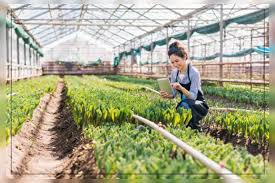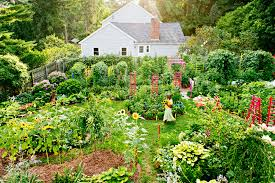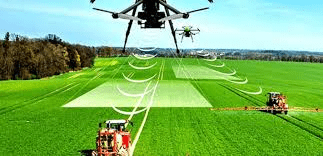Agriculture is the practice of growing plants and raising animals for food, fiber, and other products. It is essential for human survival and has evolved over thousands of years into various methods, each with its own techniques and goals.
Understanding these types can help us appreciate how food is produced and how it affects our environment and society.
In this article, we’ll explore different types of agriculture, including traditional farming, subsistence farming, organic farming, commercial agriculture, cash crops, industrial farming, sustainable agriculture, agroecology, and permaculture.
Traditional Agriculture
Traditional agriculture refers to farming methods that have been used for centuries, often passed down through generations. This type of agriculture relies on techniques that are closely tied to the local environment and cultural practices.
1. Techniques: Farmers use manual tools like plows and hand-held sickles. They often rely on animal labor, such as oxen or horses, to help with plowing and harvesting.
2. Practices: This farming usually involves rotating crops and using natural fertilizers like compost or manure to maintain soil health. Farmers may also practice mixed cropping, where different types of crops are grown together to improve soil fertility and reduce pest problems.
3. Advantages: Traditional agriculture is often sustainable and has a minimal impact on the environment. It can help preserve local biodiversity and traditional knowledge.
4. Disadvantages: It can be less efficient and produce lower yields compared to more modern methods. Traditional farming may not always be able to meet the demands of growing populations.
Subsistence Farming

Subsistence farming is a type of agriculture where farmers grow just enough food to feed their families. There’s little or no surplus for sale.
1. Techniques: Farmers use basic tools and often practice mixed cropping or polyculture, growing multiple types of crops and raising animals together. This helps ensure a balanced diet and reduces the risk of complete crop failure.
2. Practices: Land is usually worked by hand or with simple tools. Farmers may use natural fertilizers and rely on local water sources for irrigation.
3. Advantages: Subsistence farming promotes self-sufficiency and helps maintain local food systems. It also often requires fewer resources and has a lower environmental impact.
4. Disadvantages: It can be vulnerable to weather changes, pests, and diseases. Farmers may struggle to improve their livelihoods or adapt to changing conditions.
Organic Farming
Organic farming focuses on producing food without synthetic chemicals or genetically modified organisms (GMOs). It emphasizes natural processes and sustainability.
1. Techniques: Organic farmers use natural fertilizers like compost and green manure. They avoid synthetic pesticides and herbicides, opting for biological pest control methods such as introducing beneficial insects.
2. Practices: Crop rotation is common to prevent soil depletion and control pests. Farmers may use cover crops to protect and enrich the soil.
3. Advantages: Organic farming can improve soil health and reduce pollution. It often supports biodiversity and produces food free from synthetic chemicals.
4. Disadvantages: Organic farming can be more labor-intensive and may have lower yields compared to conventional farming. It can also be more expensive for consumers.
Read Also: All You Need To Know About Mow Lawn Flowers
Commercial Agriculture

Commercial agriculture is focused on producing large quantities of crops or livestock for sale in the market. It is driven by profit and often involves large-scale operations.
1. Techniques: Farmers use advanced machinery like tractors and combines to plant, tend, and harvest crops efficiently. They may also use high-yield crop varieties and chemical fertilizers to maximize production.
2. Practices: Commercial farms often specialize in a single type of crop or livestock. They use extensive irrigation systems and may employ large-scale animal husbandry practices.
3. Advantages: This method can produce high yields and lower food prices. It can also lead to economic growth and job creation.
4. Disadvantages: Commercial agriculture can lead to environmental issues such as soil degradation, water pollution, and loss of biodiversity. It may also rely heavily on fossil fuels and synthetic chemicals.
Cash Crops
Cash crops are grown primarily for sale rather than for personal consumption. These crops are usually sold in national or international markets.
1. Techniques: Farmers often focus on growing a single cash crop, such as cotton, coffee, or sugarcane, using modern farming techniques to increase productivity.
2. Practices: Cash crop farming typically involves monoculture, where large areas are planted with the same crop. Farmers may use chemical inputs to boost yields and control pests.
3. Advantages: Growing cash crops can be profitable and provide economic benefits to farmers and countries. It can also support global trade.
4. Disadvantages: Relying on cash crops can make farmers vulnerable to market fluctuations. It may also lead to environmental problems like soil depletion and loss of biodiversity.
Industrial Farming
Industrial farming, also known as intensive farming, involves large-scale, highly mechanized operations aimed at maximizing output.
1. Techniques: This method uses advanced machinery, synthetic chemicals, and high-yield crop varieties. It often involves factory-style animal production, where animals are kept in confined spaces.
2. Practices: Industrial farms rely on monoculture and intensive feeding practices. They use artificial inputs to increase productivity and efficiency.
3. Advantages: Industrial farming can produce a large volume of food at a lower cost. It also supports large-scale food distribution systems.
4. Disadvantages: It can lead to significant environmental damage, including pollution and habitat destruction. There are also concerns about animal welfare and the health impacts of consuming processed foods.
Sustainable Agriculture
Sustainable agriculture aims to meet current food needs while preserving the environment for future generations. It balances productivity with environmental health and social equity.
1. Techniques: Farmers use practices that protect soil, water, and biodiversity. This includes crop rotation, cover cropping, and reduced use of chemical inputs.
2. Practices: Sustainable farming often involves integrated pest management (IPM) and conservation tillage to minimize soil erosion. It may also include efforts to reduce greenhouse gas emissions.
3. Advantages: Sustainable agriculture can improve soil health, reduce pollution, and support local ecosystems. It also promotes long-term food security and resilience.
4. Disadvantages: It may require changes in farming practices and may have higher initial costs. Adoption can be slow due to economic and logistical challenges.
Agroecology
Agroecology applies ecological principles to farming systems. It focuses on creating sustainable and resilient farming practices that work with natural processes.
1. Techniques: Agroecology emphasizes biodiversity, such as planting a variety of crops and using natural predators to manage pests. It integrates traditional knowledge with modern science.
2. Practices: Farmers may use agroforestry, which combines trees and crops, and employ conservation practices to protect natural resources.
3. Advantages: Agroecology can enhance biodiversity, improve soil health, and increase resilience to climate change. It often supports local communities and economies.
4. Disadvantages: It can require significant knowledge and training. Scaling up agroecological practices can be challenging in regions with industrialized farming systems.
Read Also: All You Need To Know About Artificial Hanging Plants
Permaculture

Permaculture is a design philosophy that aims to create sustainable and self-sufficient agricultural systems by mimicking natural ecosystems.
1. Techniques: Permaculture involves designing farms and gardens that work with nature. This includes creating diverse, multi-layered systems that provide food, shelter, and energy.
2. Practices: Permaculture designs often include features like rainwater harvesting, composting, and planting perennial crops. The goal is to create a closed-loop system where waste is minimized and resources are recycled.
3. Advantages: Permaculture can lead to highly productive and resilient systems. It promotes ecological balance, reduces reliance on external inputs, and enhances local food security.
4. Disadvantages: Implementing permaculture principles can be complex and may require significant upfront investment in design and planning. It may also be challenging to integrate with conventional farming practices.
Modern Agricultural Practices
Agriculture has evolved significantly over the years, integrating new technologies and methods to increase efficiency, yield, and sustainability. Modern agricultural practices are designed to meet the growing demands for food while minimizing environmental impact. In this article, we’ll explore various modern agricultural practices, including precision farming, hydroponics and aquaponics, specialized agriculture, urban farming, vertical farming, smart farming, and biotechnology.
Precision Farming
Precision farming, also known as precision agriculture, uses technology to monitor and manage crops and livestock more accurately. The goal is to optimize field-level management regarding crop farming.
1. Techniques: Precision farming involves using GPS, drones, and sensors to collect data on crop health, soil conditions, and weather patterns. This data helps farmers make informed decisions about planting, watering, and fertilizing.
2. Practices: Farmers apply inputs like water and fertilizers precisely where and when they are needed, reducing waste and increasing efficiency. For example, variable rate technology (VRT) allows for adjusting the amount of fertilizer applied to different parts of a field based on soil nutrient levels.
3. Advantages: Precision farming can increase crop yields, reduce input costs, and minimize environmental impact by avoiding overuse of resources.
4. Disadvantages: Initial setup costs can be high, and farmers need to be trained to use the technology effectively. There may also be challenges in integrating different technologies and systems.
Hydroponics and Aquaponics
Hydroponics and aquaponics are soilless farming methods that use nutrient-rich water to grow plants.
Hydroponics
1. Techniques: Hydroponics involves growing plants in a nutrient solution rather than soil. There are several systems, including nutrient film technique (NFT), deep water culture (DWC), and drip systems.
2. Practices: Plants are supported by an inert growing medium like perlite or rock wool. Nutrients are delivered directly to the plant roots through a water solution, which is recirculated to reduce waste.
3. Advantages: Hydroponics can produce faster growth and higher yields compared to traditional soil-based growing. It also uses less water and space, making it suitable for urban environments.
4. Disadvantages: It requires careful monitoring of nutrient levels and pH. The initial setup cost can be high, and there’s a risk of disease spreading quickly in a closed system.
Aquaponics
1. Techniques: Aquaponics combines hydroponics with aquaculture (raising fish). In this system, fish waste provides nutrients for the plants, and the plants help clean the water for the fish.
2. Practices: Fish are kept in tanks, and water from the fish tanks is circulated through the plant grow beds. The plants absorb nutrients from the water, which is then filtered and returned to the fish tanks.
3. Advantages: Aquaponics creates a symbiotic environment where both fish and plants benefit. It is efficient in water use and can produce both fish and vegetables.
4. Disadvantages: Managing an aquaponics system requires knowledge of both fish and plant care. The system can be complex and requires ongoing maintenance to ensure balance between fish and plant needs.
Specialized Agriculture

Specialized agriculture focuses on growing specific types of crops or raising particular types of livestock. This method is often used to meet niche market demands or to maximize efficiency for a particular product.
1. Techniques: Farmers might specialize in growing high-value crops like gourmet mushrooms, exotic fruits, or medicinal herbs. In livestock, specialization might involve breeding specific breeds of cattle for meat quality or dairy production.
2. Practices: Specialized agriculture often involves intense management practices tailored to the specific needs of the crop or animal. This might include specialized feeding programs, pest management strategies, and breeding techniques.
3. Advantages: Specialization can lead to higher quality products and more efficient production. It can also allow farmers to command higher prices for their products.
4. Disadvantages: Specialization can make farmers more vulnerable to market fluctuations and diseases. It may also require higher levels of expertise and investment in specific equipment and resources.
Urban Farming
Urban farming refers to growing food within city environments. It aims to bring agriculture closer to where people live, making fresh produce more accessible and reducing food miles.
1. Techniques: Urban farming can include community gardens, rooftop farms, and indoor farms. Techniques used might include container gardening, raised beds, and hydroponics.
2. Practices: Urban farms often use space-saving methods and may integrate with other city functions, such as using rooftop gardens to provide insulation for buildings or incorporating edible landscaping in public spaces.
3. Advantages: Urban farming can increase access to fresh produce, reduce transportation costs, and promote community engagement. It can also help address food insecurity in city areas.
4. Disadvantages: Urban farming may face challenges such as limited space and higher costs for land. There can also be issues with soil contamination and access to resources.
Vertical Farming
Vertical farming involves growing crops in stacked layers or vertically inclined surfaces. It’s designed to maximize space usage and increase food production in urban areas.
1. Techniques: Vertical farms use controlled environment agriculture (CEA) techniques, which may include hydroponics, aeroponics, or aquaponics. The use of artificial lighting and climate control systems is common.
2. Practices: Plants are grown in layers, often in racks or towers, allowing for high-density production. Vertical farms are typically located in urban areas, using indoor spaces or building rooftops.
3. Advantages: Vertical farming can produce large amounts of food in a small footprint and reduce the need for transportation. It also minimizes exposure to pests and weather-related issues.
4. Disadvantages: The initial setup cost can be high due to the need for specialized equipment and infrastructure. Energy use for lighting and climate control can also be significant.
Emerging Trends in Agriculture
Agriculture is continuously evolving, with new technologies and methods emerging to address global challenges. Some of the most exciting trends include smart farming and biotechnology.
Smart Farming
1. Techniques: Smart farming uses data and technology to improve farm management. This includes the use of Internet of Things (IoT) devices, sensors, and data analytics to monitor and manage agricultural operations.
2. Practices: Smart farming involves using real-time data to make decisions about irrigation, fertilization, and pest control. Automation and robotics may also be used for tasks like planting, harvesting, and monitoring crops.
3. Advantages: Smart farming can increase efficiency, reduce waste, and improve crop yields. It also helps farmers make more informed decisions based on data.
4. Disadvantages: Implementing smart farming technologies can be expensive and require technical expertise. There can also be concerns about data security and privacy.
Biotechnology in Agriculture
1. Techniques: Biotechnology involves using genetic engineering, gene editing, and other biotechnological tools to improve crops and livestock. This includes developing genetically modified (GM) crops that are resistant to pests, diseases, or environmental conditions.
2. Practices: Biotechnology may be used to create crops with enhanced nutritional content or to develop new plant varieties with specific traits. It can also involve using microbes to improve soil health or crop productivity.
3. Advantages: Biotechnology can increase crop yields, improve resistance to pests and diseases, and enhance the nutritional content of food. It also offers potential solutions for food security and environmental sustainability.
4. Disadvantages: There are concerns about the safety and environmental impact of GM crops. Public perception and regulatory challenges can also be significant hurdles.
Conclusion
Modern agricultural practices are transforming the way we produce food, making it more efficient, sustainable, and adaptable to changing conditions. Precision farming, hydroponics, aquaponics, specialized agriculture, urban farming, vertical farming, smart farming, and biotechnology each play a role in addressing global food challenges. Understanding these practices helps us appreciate the innovations in agriculture and their potential to improve food security and environmental health.
Read Also: A Guide to Waste Management Case Studies
